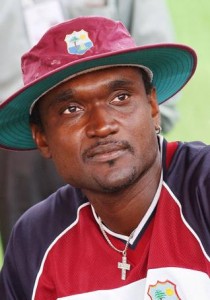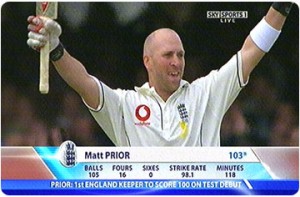
A gradual but inevitable descent into cricket-based loathing and bile.
The 51allout Bargain Basement Book Bonanza: Paul Donnelley’s ‘Firsts, Lasts and Onlys’
Cancer is a bitch. And like all bitches, it must be fought. Here at 51allout we are happy to do our bit and have heeded the Kitchener-like call to battle. It was an honour and a pleasure to do our duty and nip down to the local Cancer Care Trust shop and scour the bookshelves for another book about cricket. We hope our £1.00 will make a real difference.
Miscellanea is great. Did you know miscellanea was first referenced in the 16th Century and etymologically stems from the Latin word miscellāneus? Our book review this week is basically a QI / Schott’s Miscellany for the cricketing world and its subtitle is rather grand: “Paul Donnelley presents the most amazing cricket facts from the last 500 years”.

We are contractually obliged to post a picture of Carl Hooper whenever someone says the word ‘amazing’.
Well, at first the book seems to be a good stocking filler and is handily-sized for reading on the loo, in the bath or under a concrete culvert whilst hiding from bullies. There are literally plenty of facts here. Some, if not all, of the facts don’t quite meet the definition of amazing, but the following at least raised an eyebrow:
- the first known public house name referencing cricket was The Eleven Cricketers (in Gravesend) in 1735.
- in the 17th Century, stumps could be six feet wide.
- in 1838 the Commercial Journal noted that ‘low slang and insulting remarks so often resorted to by Australians’ was sledging.
- Charles Bannerman, whose record for the highest proportion of a team’s Test innings still stands from the inaugural Test, only scored one First Class hundred.
- The first team score of more than 800 in First Class matches was made by the Non-Smokers against the Smokers.
- WG Grace’s last Test match was Wilfred Rhodes’ first.
- England Test captain and Olympic gold medallist boxer Johnny Douglas died when two ships crashed into each other off the Danish coast; the ships were captained by a pair of brothers who has just sent each other Christmas greetings not knowing their ships were on a collision course.
- Leslie Hylton is the only Test cricketer to be executed.
- The First Class cricketer with the longest surname is Ilikena Lasarusa Talebulamainavaleniveivakabulaimainakulalakebalau.
The book is arranged chronologically, which means the latter part is full of facts that aren’t actually amazing at all. That Matt Prior was the first England wicketkeeper to score a century on Test debut doesn’t exactly boggle the mind.
In fact, it’s during the post-war period that we began to notice errors in the book, which considering that no less than Jeremy Beadle described the author as ‘one of the world’s leading oddity hunters’ is rather inexcusable. Jim Laker is not the only player to take ten wickets in a Test innings. The last occurrence of a bowler taking ten wickets in an English First Class innings was not 1964. Fred Titmus was not the last player to do the double. We could go on. If Gary Sobers really did take his 100th wicket in his final Test, it must have been a hell of a performance to take another 135 in the same game (and apparently he was the first West Indian to take 100 Test wickets at the same time. Really?). John Murray is alleged to be the only ‘keeper with 1,500 First Class dismissals. The Parks family are said to be the last family to have had three generations play First Class cricket – even though the Headleys have three generations of Test cricketer.
In short, we now aren’t sure how many of the actually interesting facts in this book are true. Maybe there’s another Fijian cricketer with an even longer surname than Talebulamainavaleniveivakabulaimainakulalakebalau.
But at least our pound went to a good cause.


No Comments
Post a Comment